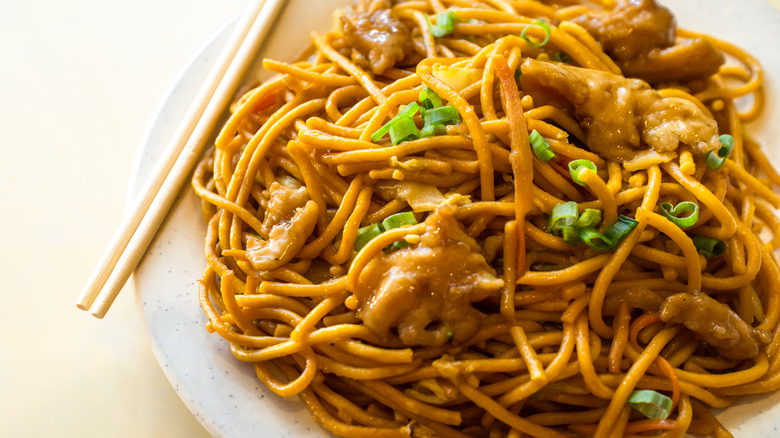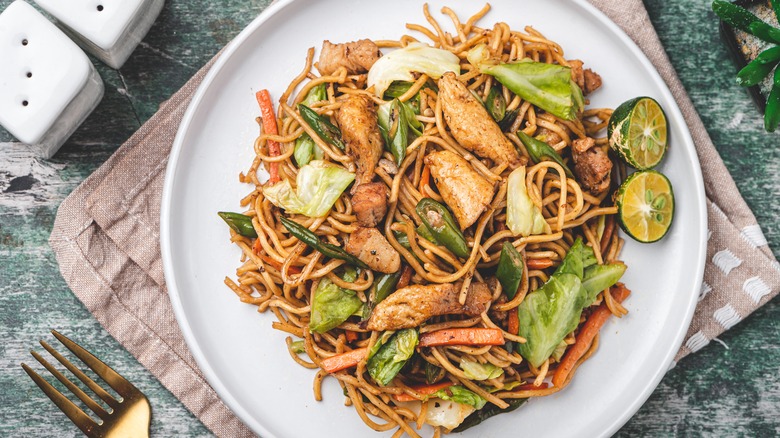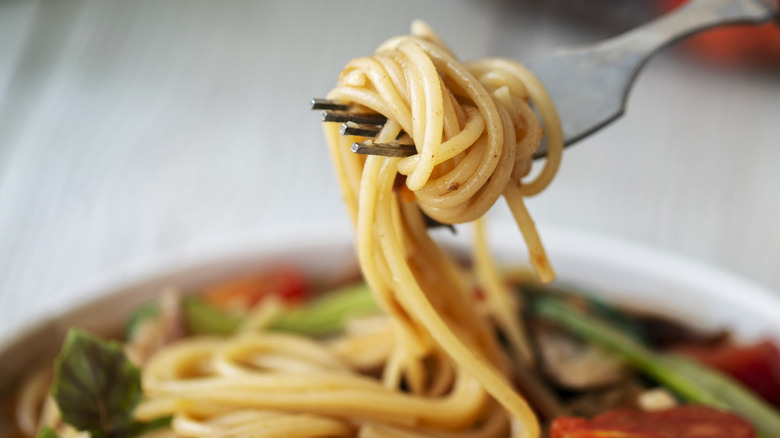How To Substitute Lo Mein Noodles In A Recipe
Take a look at any Chinese food take-out menu and you'll find a dizzying array of noodles to choose from, like soft sheets of Cheung fun, dainty threads of mei fun, transparent glass noodles called fen si, and those glorious strings of egg noodles that go into piping hot lo mein. Safe to say, you may not always have the right noodles on hand for when a craving strikes, but luckily enough, it's easy to swap them around, especially if it's lo mein that you're making.
The best substitute for lo mein noodles are chow mein noodles because they are both essentially the same thing. In fact, lo mein and chow mein dishes are famously confused for each other and, while they are two separate meals with different preparation methods, the noodles used in both are the same. Both are made from wheat flour and eggs, both have a smooth thickness that's heftier than spaghetti, and both noodles have a bite to them.
The only difference is that, while chow mein noodles can be either fresh or dried, lo mein is best made fresh. And, if you're using dried noodles, be careful of the cooking time: Where fresh lo mein noodles reach an al dente texture in as little as two minutes, dried noodles can take up to six minutes to cook.
Lo mein noodle substitutes beyond chow mein
There are plenty of noodles that can replace the slippy wheat strands that go into lo mein. Take chop suey noodles, for example, which are made from the same dough comprised of water and wheat flour that's used to make lo mein noodles, just sans the eggs. These long strands are particularly good at soaking up the favors of whatever they are cooked with, making them excellent substitutes in a dish that is covered in thick sauce — like lo mein.
Vermicelli and rice-based noodles such as those that go into pad Thai are other alternatives that can work in a pinch. Where rice noodles are made from rice flour instead of wheat (meaning many are egg-free and gluten-free), vermicelli is made from durum semolina. When using rice noodles instead of lo mein noodles, be sure to take into account that the former needs to be soaked in water before it can be tossed in a sauce.
Udon and ramen noodles will also work but, when in doubt, it's good to remember that the star of lo mein is the sauce more than the noodles. This is why just about any long noodle can be tossed into lo mein, though the cooking time and method may change. Alternatively, you could even make your own egg noodles for lo mein: All you need is some flour, water, salt, and a few eggs.
Don't be afraid to swap the noodles with pasta
Some may consider it blasphemous to compare pasta with Asian noodles, let alone swap one for another, but let's be honest, there are similarities between the Chinese egg noodles that go into lo mein and pastas such as spaghetti. Both are made from a dough of wheat flour, both are rolled and sliced into long strands, and both have a similar flavor as well as texture. Even Redditors have green-lit the swap, with users admitting that though there are differences between the two, "we improvise as needed to feed ourselves" and "what you have on hand is what you have on hand!"
The main thing to remember when swapping egg noodles with pasta noodles like spaghetti is that the latter has a lower amount of protein. As a result, it has less bite. But it's nothing a nifty little trick won't fix, and all you need is some baking soda to do so. Adding a spoonful of baking soda to the pot of water that you boil the spaghetti in will trigger a chemical reaction that will give the pasta the tooth and bounce of Chinese egg noodles. Additionally, pasta tends to absorb more sauce, so be sure to toss in more of that thick, flavorsome liquid. As long as you keep these things in mind, there's no reason to not make your lo mein with spaghetti instead.



